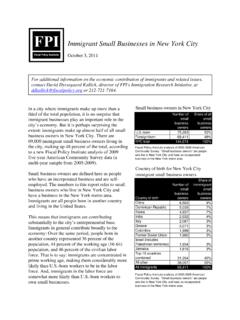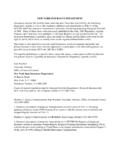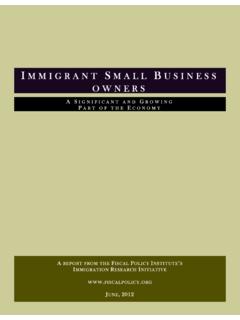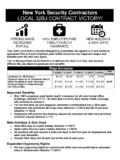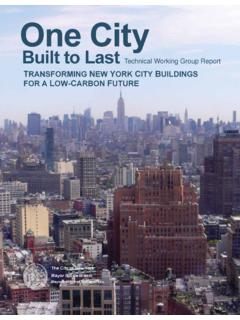Transcription of Immigrants and the Economy - fiscalpolicy.org
1 Immigrants and the EconomyContribution of Immigrant Workers to the Country s 25 Largest Metropolitan AreasFiscal Policy Institutewith a focus on the five largest metro areas in the EastIntroduction by Mike Fishman, President of 32bj Service Employees International UnionImmigrants and the EconomyContribution of Immigrant Workers to the Country s 25 Largest Metropolitan Areaswith a focus on the five largest metro areas in the EastDecember 2009 The Fiscal Policy Institute prepared this report as part of its Immigration Research Initiative. 32bj of the Service Employees International Union provided generous support that helped make this report Carnegie Corporation of New York provides the core funding of the Immigration Research FishmanPresident of 32bj Service Employees International UnionAs a new administration and congress take up immigration reform, lawmakers need to rely on hard facts about the role of immigrant workers in our Economy if they are to deliver a responsible bill to the President for his signature.
2 Congress has come close to passing comprehensive immigration reform in recent years, but fell short time and again when politics, disinformation and heated rhetoric trumped the urgent need to overhaul a system that is hurting not just immigrant workers but workers and our Economy . Immigrants and the Economy , which was prepared by the Fiscal Policy Institute, aims to provide legislators, policy makers, stakeholders and the public with the eco-nomic data they should rely on to bring our country s immigration system into line with today s economic and social realities. By looking at each of the 25 largest metro-politan areas in the country, the report provides a fresh perspective on the issue one that can inform lawmakers in Washington when drafting legislation and also cast new light on the issue for sometimes skeptical state and local union s long-standing position on immigration reform is clear: We fully support a comprehensive solution to our broken and outdated immigration system.
3 Millions of undocumented men and women who are already part of our communities must be brought out of the shadows and given protection under the law. Providing these men and women with a path to citizenship would rightly protect them from unscrupulous employers who often pay less than minimum wage and provide no health care or sick days. Just as importantly, fixing our immigration system must also address a range of issues including safe and secure borders, law enforcement and the future flow of Immigrants into our country. Never again should countless workers find themselves without legal rights and current immigration system is, by all measures, broken. It fuels an under-ground Economy that forces workers into low-wage jobs and poor and often abusive conditions. It drags down wage and benefit standards that unions like ours fight to establish and maintain, and it jeopardizes economic security for millions of workers who are already struggling to make ends meet.
4 We must fix this system, and we believe this report will provide lawmakers with in-formation needed to reform our immigration system and align it with our country s economic needs and humanitarian in the Economy was produced as part of the Fiscal Policy Insti-tute s Immigration Research Initiative, an ongoing effort begun in 2006 to better understand the role of Immigrants in the first major report of the initiative, Working for a Better Life, examined the role Immigrants play in three regions of New York State New York City, the downstate suburbs, and upstate New York. Immigrants in the Economy extends the same question to the 25 largest metro areas of the United and the Economy was undertaken with the support of 32bj of the Service Employees International Union, which represents more than 110,00 service workers in eight states and the District of Columbia. The Fiscal Policy Institute s Immigration Research Initiative is made possible by the continuing support of the Carnegie Corporation of New York.
5 The principal author of Immigrants in the Economy is David Dyssegaard Kallick, senior fellow of the Fiscal Policy Institute and director of its Im-migration Research Initiative. The work was improved by the constant input and recommendations of James Parrott, chief economist and deputy director of the Fiscal Policy Institute, and was conducted under the over-sight of Frank Mauro, Fiscal Policy Institute s executive director. Research assistant Jonathan DeBusk provided the majority of the data analysis, with significant contributions from FPI research associate Michele Mattingly and demographic analyst Vicky Virgin. Jo Brill, FPI s communications di-rector, helped keep the numbers straight and the charts readable. The Immigration Research Initiative is guided by an outstanding expert ad-visory panel. Current members of the panel, listed at the back of this report, provided indispensable feedback on drafts of this report.
6 Their collective wisdom immeasurably improved the product, although they are of course not responsible for any remaining errors. In addition, Fiscal Policy Institute would like to recognize the contributions of two former advisory panel mem-bers. Walter Stafford, professor of Urban Planning and Public Policy at the New York University s Wagner School of Public Service, was continually en-couraging, challenging, and insightful. He passed away in September 2008, and will be sorely missed. Jared Bernstein formerly of the Economic Policy Institute (EPI) and currently chief economist and economic policy advisor to Vice President Joseph R. Biden took valuable time reviewing our work while at EPI, keeping it grounded in the economic literature and always mak-ing penetrating analysis of American Community Survey microdata by metro area ben-efited from the gracious assistance provided by Audrey Singer and Jill Wilson of the Brookings Institution s Metropolitan Policy Program.
7 Matt Nerzig and Eugenio Villasante of 32bj SEIU provided numerous valuable contributions throughout the process. Leyla Vural helped make the report more readable and cover and interior of the report were designed by Alberto and methodological notes 33 Sources and methodological notes for figures 34 Appendix A: Counties in the 25 largest Metropolitan Statistical Areas 35 Appendix B: Occupational groupings used in Immigrants and the Economy 38 Endnotes 42 Expert Advisory Panel to FPI s Immigration Research Initiative(Listed on the inside back cover) Table of ContentsExecutive Summary 1 Immigrants and the Economy1. Overview of Immigrants in the 25 largest metro areas 5 2. Growth in immigrant share of labor force parallels economic growth 8 3. Immigrants contribute to the Economy in proportion to their share of the population 10 4. Immigrants and workers share favorable earnings at the top of the occupational ladder but face difficulties at the bottom 14 5.
8 Immigrants are playing an important role in unions, helping to improve pay and equalize earnings among workers doing the same jobs 19 6. An in-depth look at the five largest metro areas in the East 21 Executive Summaryhis report examines the economic role of immi-grants in the 25 largest metropolitan areas in the United States. The results are clear: Immigrants contribute to the Economy in direct relation to their share of the population. The Economy of metro areas grows in tandem with immigrant share of the labor force. And, im-migrants work across the occupational spectrum, from high-paying professional jobs to low-wage service contribute significantly to the Economy . In the 25 largest metropolitan areas combined, Immigrants make up 20 percent of the population and are responsible for 20 percent of economic output. Together, these metro areas comprise 42 percent of the total population of the country, 66 percent of all Immigrants , and half of the country s total Gross Domestic Product.
9 This report looks at all resi-dents who were born in another country, regardless of im-migration status or year of arrival in the United Immigration and economic growth of metro areas go hand in handAn analysis of data from the past decade and a half show that in the 25 largest metropolitan areas, immigration and economic growth go hand in hand. That s easily understandable: Eco-nomic growth and labor force growth are closely connected, and Immigrants are likely to move to areas where there are jobs, and not to areas where there are 1990 and 2006, the metropolitan areas with the fastest economic growth were also the areas with the greatest increase in immigrant share of the labor force. The economies of Phoenix, Dallas, and Hous-ton saw the fastest growth in immigrant share of labor force, while all showed well above average e conom icgrowth in these years and Phoenix experienced the T* This report uses wage and salary earnings plus proprietors income as a proxy for economic output.
10 In this, the analysis follows the Bureau of Economic Analysis estimates for metropolitan areas. These two factors together represent 64 percent of GDP. Data for the combined years 2005-2007 is shown as 2006 in the text of this report, while figures retain the information that the data comes from a three-year file combining 2005, 2006, and growth of all metro areas. By contrast, Cleve-land, Pittsburgh and Detroit metro areas experienced the slowest economic growth and among the smallest increases in immigrant share of labor force.*Economic growth does not guarantee, however, that pay and other conditions of employment improve significant-ly for all workers. The challenge is to make sure that im-migrants and workers struggling in low-wage jobs share in the benefits of economic Immigrants contribute to the Economy in propor-tion to their share of the populationThe most striking finding in the analysis of 25 metro ar-eas is how closely immigrant share of economic output matches immigrant share of the population.
